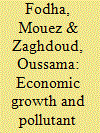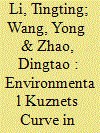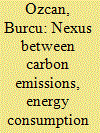|
|
|
Sort Order |
|
|
|
Items / Page
|
|
|
|
|
|
|
| Srl | Item |
| 1 |
ID:
112917


|
|
|
|
|
| Publication |
2012.
|
| Summary/Abstract |
This paper explores the relationship between CO2 emissions and economic activity for 31 countries (28 OECD, Brazil, China, and India) during the period 1950 to 2006 using cointegration analysis. Single country long run relationships are estimated, and equality in the functional form, the parameters, and the turning point, when appropriate, are rejected. This confirms the relevance of considering the differences among countries in the relationship between air pollution and economic activity to avoid wrong estimations and conclusions.
|
|
|
|
|
|
|
|
|
|
|
|
|
|
|
|
| 2 |
ID:
162338


|
|
|
|
|
| Summary/Abstract |
Prior work has suggested that cultivating environmentally friendly energy sources can strike a balance between reducing CO2 emissions and fostering economic growth, yet little is known about whether and how energy-mix policies tap into the balance. Energy-mix is important mainly because maintaining energy supplies exclusively using renewable energy sources is not completely feasible. Our study takes a contingent approach to energy mix policies and suggests that the appropriate mix for reducing carbon emissions is not static but dynamic depending on the developmental stages of national economic systems. We follow the Environmental Kuznets Curve (EKC) hypothesis, the most influential model for relating CO2 emissions to economic development, but depart from it by utilizing multifactor productivity data, rather than the conventional measure of GDP per capita, to capture economic growth. Empirical analyses of OECD countries from 1985 to 2013 show that the best energy policies for OECD countries is the gradual decrease in their relative reliance on natural gas, nuclear power, bio and waste fuels in a short run, over the next about 9, 2 and 5 years respectively, whereas solar and wind power can decrease CO2 in a long run as the economy continues to grow.
|
|
|
|
|
|
|
|
|
|
|
|
|
|
|
|
| 3 |
ID:
162343


|
|
|
|
|
| Summary/Abstract |
Prior work has suggested that cultivating environmentally friendly energy sources can strike a balance between reducing CO2 emissions and fostering economic growth, yet little is known about whether and how energy-mix policies tap into the balance. Energy-mix is important mainly because maintaining energy supplies exclusively using renewable energy sources is not completely feasible. Our study takes a contingent approach to energy mix policies and suggests that the appropriate mix for reducing carbon emissions is not static but dynamic depending on the developmental stages of national economic systems. We follow the Environmental Kuznets Curve (EKC) hypothesis, the most influential model for relating CO2 emissions to economic development, but depart from it by utilizing multifactor productivity data, rather than the conventional measure of GDP per capita, to capture economic growth. Empirical analyses of OECD countries from 1985 to 2013 show that the best energy policies for OECD countries is the gradual decrease in their relative reliance on natural gas, nuclear power, bio and waste fuels in a short run, over the next about 9, 2 and 5 years respectively, whereas solar and wind power can decrease CO2 in a long run as the economy continues to grow.
|
|
|
|
|
|
|
|
|
|
|
|
|
|
|
|
| 4 |
ID:
116925


|
|
|
|
|
| Publication |
2012.
|
| Summary/Abstract |
This paper attempts to establish a long-run as well as causal relationship between economic growth and carbon dioxide (CO2) emissions for Malaysia. Using data for the years from 1980 to 2009, the Environmental Kuznets Curve (EKC) hypothesis was tested utilizing the Auto Regressive Distributed Lag (ARDL) methodology. The empirical results suggest the existence of a long-run relationship between per capita CO2 emissions and real per capita Gross Domestic Product (GDP) when the CO2 emissions level is the dependent variable. We found an inverted-U shape relationship between CO2 emissions and GDP in both short and long-run, thus supporting the EKC hypothesis. The Granger Causality test based on the Vector Error Correction Model (VECM) presents an absence of causality between CO2 emissions and economic growth in the short-run while demonstrating uni-directional causality from economic growth to CO2 emissions in the long-run.
|
|
|
|
|
|
|
|
|
|
|
|
|
|
|
|
| 5 |
ID:
094400


|
|
|
|
|
| Publication |
2010.
|
| Summary/Abstract |
This paper investigates the relationship between economic growth and pollutant emissions for a small and open developing country, Tunisia, during the period 1961-2004. The investigation is made on the basis of the environmental Kuznets curve hypothesis, using time series data and cointegration analysis. Carbon dioxide (CO2) and sulfur dioxide (SO2) are used as the environmental indicators, and GDP as the economic indicator. Our results show that there is a long-run cointegrating relationship between the per capita emissions of two pollutants and the per capita GDP. An inverted U relationship between SO2 emissions and GDP has been found, with income turning point approximately equals to $1200 (constant 2000 prices) or to $3700 (in PPP, constant 2000 prices). However, a monotonically increasing relationship with GDP is found more appropriate for CO2 emissions. Furthermore, the causality results show that the relationship between income and pollution in Tunisia is one of unidirectional causality with income causing environmental changes and not vice versa, both in the short-run and long-run. This implies that an emission reduction policies and more investment in pollution abatement expense will not hurt economic growth. It could be a feasible policy tool for Tunisia to achieve its sustainable growth in the long-run.
|
|
|
|
|
|
|
|
|
|
|
|
|
|
|
|
| 6 |
ID:
097246


|
|
|
|
|
| Publication |
2010.
|
| Summary/Abstract |
This paper attempts to estimate the environmental Kuznets curve (EKC) in the case of France by taking the role of nuclear energy in electricity production into account. We adopt the autoregressive distributed lag (ARDL) approach to cointegration as the estimation method. Additionally, we examine the stability of the estimated models and investigate the Granger causality relationships between the variables in the system. The results from our estimation provide evidence supporting the EKC hypothesis, and the estimated models are shown to be stable over the sample period. The uni-direction running from other variables to CO2 emissions are confirmed from the casualty tests. Specifically, the uni-directional causality relationship running from nuclear energy to CO2 emissions statistically provides evidence on the important role of nuclear energy in reducing CO2 emissions.
|
|
|
|
|
|
|
|
|
|
|
|
|
|
|
|
| 7 |
ID:
113445


|
|
|
|
|
| Publication |
2012.
|
| Summary/Abstract |
This article extends the recent findings of Liu (2005), Ang (2007), Apergis et al. (2009) and Payne (2010) by implementing recent bootstrap panel unit root tests and cointegration techniques to investigate the relationship between carbon dioxide emissions, energy consumption, and real GDP for 12 Middle East and North African Countries (MENA) over the period 1981-2005. Our results show that in the long-run energy consumption has a positive significant impact on CO2 emissions. More interestingly, we show that real GDP exhibits a quadratic relationship with CO2 emissions for the region as a whole. However, although the estimated long-run coefficients of income and its square satisfy the EKC hypothesis in most studied countries, the turning points are very low in some cases and very high in other cases, hence providing poor evidence in support of the EKC hypothesis. CO2 emission reductions per capita have been achieved in the MENA region, even while the region exhibited economic growth over the period 1981-2005. The econometric relationships derived in this paper suggest that future reductions in CO2 emissions per capita might be achieved at the same time as GDP per capita in the MENA region continues to grow.
|
|
|
|
|
|
|
|
|
|
|
|
|
|
|
|
| 8 |
ID:
101464


|
|
|
|
|
| Publication |
2010.
|
| Summary/Abstract |
This paper constructs a comprehensive dataset of oil and total energy embedded in world trade of manufacturing goods for 73 countries from 1978 to 2000. Applying the data to debates on the dependency on foreign energy sources makes clear that achieving complete energy independence in the foreseeable future is unlikely to be feasible and may not be desirable. Applying it to the discussion of environmental Kuznets curves (EKCs) highlights an important distinction between production and consumption of energy. Richer countries use relatively less energy in their industrial production yet still consume relatively large amounts of energy indirectly. A further investigation largely excludes structural shifts of production in and out of the manufacturing sector as an explanation for the downward-sloping portion of the EKC. Country-level analyses add caveats but show tentative support for the cross-country conclusions.
|
|
|
|
|
|
|
|
|
|
|
|
|
|
|
|
| 9 |
ID:
124714


|
|
|
|
|
| Publication |
2013.
|
| Summary/Abstract |
This paper tests for the short and long-run relationship between economic growth, carbon dioxide (CO2) emissions and energy consumption, using the Environmental Kuznets Curve (EKC) by employing both the aggregated and disaggregated energy consumption data in Malaysia for the period 1980-2009. The Autoregressive Distributed Lag (ARDL) methodology and Johansen-Juselius maximum likelihood approach were used to test the cointegration relationship; and the Granger causality test, based on the vector error correction model (VECM), to test for causality. The study does not support an inverted U-shaped relationship (EKC) when aggregated energy consumption data was used. When data was disaggregated based on different energy sources such as oil, coal, gas and electricity, the study does show evidences of the EKC hypothesis. The long-run Granger causality test shows that there is bi-directional causality between economic growth and CO2 emissions, with coal, gas, electricity and oil consumption. This suggests that decreasing energy consumption such as coal, gas, electricity and oil appears to be an effective way to control CO2 emissions but simultaneously will hinder economic growth. Thus suitable policies related to the efficient consumption of energy resources and consumption of renewable sources are required.
|
|
|
|
|
|
|
|
|
|
|
|
|
|
|
|
| 10 |
ID:
093466


|
|
|
|
|
| Publication |
2010.
|
| Summary/Abstract |
This study revisits the environmental Kuznets curve (EKC) hypothesis for water pollution by using a recent dynamic technique, which is the generalized method of moments (GMM) approach, for a board sample of 97 countries during the period 1980-2001. On a global scale, as we cannot obtain the EKC relationship between real income and biological oxygen demand (BOD) emissions, this paper further classifies these countries into four regional groups - Africa, Asia and Oceania, America, and Europe - to explore whether the different regions have different ECK relationships. The empirical results show evidence of the inverted U-shaped EKC relationships' existence in America and Europe, but not in Africa and Asia and Oceania. Thus, the regional difference of EKC for water pollution is supported. Furthermore, the estimated turning points are, approximately, US$13,956 and US$38,221 for America and Europe, respectively.
|
|
|
|
|
|
|
|
|
|
|
|
|
|
|
|
| 11 |
ID:
150888


|
|
|
|
|
| Summary/Abstract |
This paper applies a panel of 28 provinces of China from 1996 to 2012 to study the impacts of economic development, energy consumption, trade openness, and urbanization on the carbon dioxide, waste water, and waste solid emissions. By estimating a dynamic panel model with the system Generalized Method of Moments (GMM) estimator and an autoregressive distributed lag (ARDL) model with alternative panel estimators, respectively, we find that the Environmental Kuznets Curve (EKC) hypothesis is well supported for all three major pollutant emissions in China across different models and estimation methods. Our study also confirms positive effects of energy consumption on various pollutant emissions. In addition, we find some evidence that trade and urbanization may deteriorate environmental quality in the long run, albeit not in the short run. From policy perspective, our estimation results bode well for Chinese government's goal of capping greenhouse emissions by 2030 as outlined in the recent China-US climate accord, while containing energy consumption and harm effects from expanding trade and urbanization remains some environmental challenges that China faces.
|
|
|
|
|
|
|
|
|
|
|
|
|
|
|
|
| 12 |
ID:
149887


|
|
|
|
|
| Summary/Abstract |
There is an increasing interest in investigating the environmental Kuznets curve (EKC) hypothesis because it suggests the existence of a turning point in the economy that will lead to a sustainable development path. Although many studies have focused on the EKC, only a few empirical studies have focused on analyzing the EKC with specific reference to Indonesia, and none of them have examined the potential of renewable energy sources within the EKC framework. This study attempts to estimate the EKC in the case of Indonesia for the period of 1971–2010 by considering the role of renewable energy in electricity production, using the autoregressive distributed lag (ARDL) approach to cointegration as the estimation method. We found an inverted U-shaped EKC relationship between economic growth and CO2 emissions in the long run. The estimated turning point was found to be 7729 USD per capita, which lies outside of our sample period. The beneficial impacts of renewable energy on CO2 emission reduction are observable both in the short run and in the long run. Our work has important implications both for policymakers and for the future development of renewable energy in Indonesia.
|
|
|
|
|
|
|
|
|
|
|
|
|
|
|
|
| 13 |
ID:
121334


|
|
|
|
|
| Publication |
2013.
|
| Summary/Abstract |
As environmental problems in Mainland China are receiving global increasing attentions, environmental Kuznets curve (EKC) is adopted here to validate time route of improvement for its various areas. The results indicate that some areas, such as Shanghai, Tibet, Guizhou, Jilin and Beijing have overstepped their inflection points; Liaoning, Anhui, Fujian, Hainan and Qinghai have no inflection points, and meanwhile it is about seven years for the others areas take to reach their inflection points. Therefore, it is essential to lay down some policies to change or advance the process of reaching inflection point for each area respectively.
|
|
|
|
|
|
|
|
|
|
|
|
|
|
|
|
| 14 |
ID:
133244


|
|
|
|
|
| Publication |
2014.
|
| Summary/Abstract |
Environmental degradation has become a central issue of discussion among the economists and environmentalists. In view of Malaysia's position as one of the main contributors to CO2 emissions in Asia and its status as a fast growing economy, it is vital, therefore, to conduct a study to identify the relationship between economic growth and CO2 emissions for Malaysia. This study attempts to examine empirically the environmental Kuznets curve hypothesis for Malaysia in the presence of foreign direct investment and trade openness both in the short- and long-run for the period 1970 to 2008.The bounds testing approach and Granger causality methodology are applied to test the interrelationships of the variables. The results of our study indicate that the inverted-U shaped relationship does exist between economic growth and CO2 emission in both the short- and long-run for Malaysia after controlling for two additional explanatory variables, namely FDI and trade. Importantly, the results of the study also provide some crucial policy recommendations to the policy makers.
|
|
|
|
|
|
|
|
|
|
|
|
|
|
|
|
| 15 |
ID:
125823


|
|
|
|
|
| Publication |
2013.
|
| Summary/Abstract |
The environmental Kuznets curve (EKC) hypothesis assumes that there is an inverted U-shaped relationship between environmental degradation and income per capita. In other words, as a country grows, it is assumed that its environmental quality improves. In this study, we aim to test the EKC hypothesis for 12 Middle East countries during the period 1990-2008 by employing recently developed panel data methods. Our results provide evidence contrary to the EKC hypothesis. We found evidence favorable to the U-shaped EKC for 5 Middle East countries, whereas an inverted U-shaped curve was identified for only 3 Middle East countries. Furthermore, there appear to be no causal links between income and CO2 emissions for the other 4 countries. Regarding the direction of causality, there appears to be a unidirectional causality from economic growth to energy consumption in the short-run; in the long-run, however, the unidirectional causality chain runs from energy consumption and economic growth to CO2 emissions. We also suggest some crucial policy implications depending on these results.
|
|
|
|
|
|
|
|
|
|
|
|
|
|
|
|
| 16 |
ID:
143365


|
|
|
|
|
| Summary/Abstract |
This paper provides a specific application of the environmental Kuznets curve (EKC) in order to explain the effect of population growth on the environment. The main purpose is contributing to enhance the connection between theoretical and empirical analysis. We develop an overlapping generations (OLG) model that featured with an inverted U-shaped relationship between pollution emission and income and we examine the effect of population growth on this relationship. Simulations illustrate the model's predictions that positive population growth makes the EKC steeper and have higher peak, but it does not fundamentally change the pollution–income relationship. The econometric analysis finds evidence supporting our model's predictions using Chinese data at the province level.
|
|
|
|
|
|
|
|
|
|
|
|
|
|
|
|
| 17 |
ID:
162331


|
|
|
|
|
| Summary/Abstract |
Rapid urbanization and economic development caused serious environmental pollution burden in China. This study explored the spatiotemporal profile of PM2.5 concentrations in China from 1998 to 2016, examined its relationship with urbanization and other socioeconomic factors, including industry, abatement investment, and clean energy consumption by constructing the Environmental Kuznets Curve (EKC) model, and interpreted its responses to urbanization and these factors using the Generalized Additive Model (GAM). The results showed that PM2.5 pollution generally presented a worsening situation in most provinces during the study period. PM2.5-urbanization relationship approved an inverted U-shape EKC pattern in whole China and the central and eastern region, but presented an N-shape EKC pattern in the developed eastern region. Industry and its interaction with urbanization drove increasing PM2.5 concentrations. The interactions of urbanization with abatement investment and clean energy consumption had negative effects on PM2.5 concentrations nationally, but showed different impacts across regions. The GAM's results further verified that PM2.5 concentrations increased along with urbanization and industry, but enhancing abatement investment and clean energy consumption can reverse the increased trend. The major findings and policy implications can contribute to successful policy-making aimed at successful PM2.5 pollution abatement.
|
|
|
|
|
|
|
|
|
|
|
|
|
|
|
|
| 18 |
ID:
106237


|
|
|
|
|
| Publication |
2011.
|
| Summary/Abstract |
Intuitively, the concept of an Environmental Kuznets Curve (EKC) is relatively easy to understand: pollution will initially increase with economic development but then decrease again as incomes attain a certain level. The overall concept of pollution, however, actually consists of various components which may behave differently and are not easily combined into a single measure. As a result, the measurement or tracking of an EKC becomes more difficult as one tries to develop a tractable measure of pollution for modeling or policy purposes. For example, in China levels of sulfur dioxide and particulate pollution show some signs of diminishing while nitrogen dioxide levels have increased as China's auto fleet has grown. Consequently, different studies estimating an EKC often generate different results depending upon which pollutant is used and how it is measured. This paper generates composite measures of Chinese air pollution using Nemerow methodology as well as a new epidemiological index based upon the health effects of the pollutants. The paper then tests these index measures to determine whether they display evidence of an EKC and also to examine how they behave in comparison to the individual pollutants.
|
|
|
|
|
|
|
|
|
|
|
|
|
|
|
|
| 19 |
ID:
086203


|
|
|
|
|
| Publication |
2009.
|
| Summary/Abstract |
This paper aims at estimating the Environmental Kuznets Curve (EKC) for the sulphur dioxide (SO2) emissions in a panel of 28 Chinese provinces. First, using a fixed effects model, econometric findings reveal an N shape EKC with a turning point of 4500 yuans (index 1990). However, a Chow test reveals a break in 1995, so that the estimation of the model indicates an increasing linear relationship between GDP per capita and SO2 emissions. The previous results imply that the decrease of the Chinese sulphur dioxide emissions during 1996-1999 did not result from the ECK but from an exogenous public action.
|
|
|
|
|
|
|
|
|
|
|
|
|
|
|
|
| 20 |
ID:
128455


|
|
|
|
|
| Publication |
2014.
|
| Summary/Abstract |
Is it possible for a country in the process of development to comply with the environmental Kuznets curve (EKC) hypothesis in the medium term? This is the question that inspired this study. This paper is an extension of a previous study focused on economic development and CO2 emissions in the coming years in Ecuador (Robalino-López et al., submitted for publication). The main goal of this paper is to analyze whether the EKC hypothesis holds within the period 1980-2025 under four different scenarios. This paper uses co-integration techniques (Stock and Watson, 2010) to test the existence of the EKC hypothesis in Ecuador in the medium term using Jaunky's (2011) specification. Our proposal goes a step further than previous contributions, and intends to see under which conditions a country could approach the fulfilment of this hypothesis in the medium term. Results do not support the fulfilment of the EKC, nevertheless, our estimations show that Ecuador could be on the way to achieving environmental stabilization in the near future if economic growth is combined with an increase in the use of renewable energies, an improvement of the productive sectoral structure, and the use of a more efficient fossil fuel technology.
|
|
|
|
|
|
|
|
|
|
|
|
|
|
|
|
|
|
|
|
|